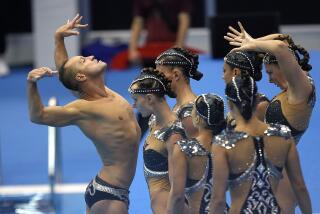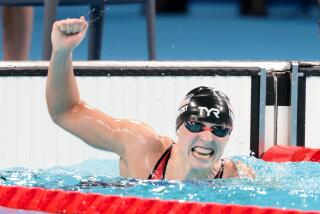Parting the Waters : She braved the English Channel and Bering Strait. Now Lynne Cox swims for a world without war.
Lynne Cox begins her final miles of training in U.S. waters by facing the shore and crashing backward into the surf. She is going against the current again, and she does it with a childlike grin visible from across the sand.
The regulars watching her from the Seal Beach Pier wave at the swimmer who, in 22 years of setting international endurance records, has become something of a hometown hero in neighboring Los Alamitos.
At 15, she shattered the women’s and men’s world records for swimming the English Channel. She went on to become the only person to brave 40-degree water and swim Russia’s Bering Strait, and she wrote history by stroking across the Beagle Channel between Argentina and Chile, the Spree River between former East and West Berlin, the shark-infested waters of the Cape of Good Hope, and Siberia’s Lake Baikal--the world’s deepest and coldest freshwater lake.
Today, Cox and her half a dozen crew members are in Israel, where, after a six-year quest, she is scheduled to attempt a 14-mile crossing of the Gulf of Aqaba, a symbolic “peace swim” in waters linking Israel, Egypt and Jordan.
“I don’t know what it’s going to take to get into Jordanian waters,” she says after ripping off blue goggles worn for the three-mile training swim. “It always comes down to the last minute. . . .
“But after all of the work, it’s always great to finally get into the water. It’s like being an artist. You’ve put out all the paint, and you’ve gotten everything ready, and you can finally pick up the brush.”
Quietly articulate, Cox comes off as an interesting blend of political intellect and athletic ability.
She has thrown out the many medals and trophies collected over years of competitive swimming. She still lives with her parents, teaches swimming, lectures and does some writing. She is not the kind of American athlete who shills for running shoes or breakfast cereal. All she wants, she says with a bashful smile, is a world without war.
On this swim, she sees a special irony in the fact that she will be stroking all 14 miles of the two-day effort against the current.
“They asked me if I wanted to change my course and swim the other way,” says Cox, 37, who scheduled the event to celebrate the Camp David accords and the ongoing peace effort between Jordan and Israel.
“But against the current really describes the whole thing,” she says, “and the whole peace process.”
*
Just three years after Albert Cox, a radiologist, and his wife, Estelle, an artist, moved Lynne and her swimming siblings to Southern California from New Hampshire in 1970, she made her mark by swimming the English Channel.
“My parents were a stable influence of encouragement,” says Cox, whose brother David, 39, runs a recreation department. Sister Laura, 35, is a geneticist who coaches swimming, and Ruth, 32, coaches water polo and teaches.
“I remember that they used to give us swimming lessons in the bathtub when we were really little,” she says. “We started competing (in New Hampshire), but all of the good coaches were in California, so they moved us out here.”
It was after the English Channel swim that Cox became intensely interested in the world around her. By her late teens, she was focusing on global peace efforts, not trophies and medals.
“I don’t even remember exactly why I threw (the trophies) out,” she says. “We used to have them displayed all over the place, but I was done with that. They went into a box, and then in the trash. I don’t swim for that anymore.”
As a history major at UC Santa Barbara, she learned about the give-and-take in attaining and maintaining peace.
“It’s the idea that a little compromise on both sides can build a bridge, and by allowing me to swim, they’re all doing that,” she says of her various host countries. “It takes a good many years to build a bridge and just seconds to blow it up.”
Her parents find it difficult to understand her drive and motivation. They just watch in awe as she pieces together each history-making swim, they say, and then fret about her. The Gulf of Aqaba swim is particularly worrisome, given Iraqi leader Saddam Hussein’s latest military maneuvering and the mobilization of U.S. troops to Kuwait.
“We worry about her safety because it’s a very volatile part of the world today, with a lot of out-of-control people,” her father says. “But we just keep our fingers crossed and hope everything goes smoothly.”
Cox’s parents have other concerns, including their daughter’s personal and financial future. Although she works once a week at Beach Physical Therapy in Seal Beach, delivers lectures to corporate executives, gives swimming lessons and picks up some free-lance writing assignments, her income is modest.
“It’s hard for us to understand why she does this and why she keeps doing this,” Albert Cox says. “Lynne is going to do what she feels she has to do. We don’t push her; we just assist her.”
Cox is undecided about her future. And she hasn’t had time to settle into a long-term relationship, she says. Marriage and children will come “maybe someday.” When asked how long she intends to pursue her historic swims, she gets mildly defensive.
“I don’t think that anyone’s ever said that I’m too old to be doing this. You’re old when you’re old,” she says. “Why should you be limited by someone else’s expectations?”
*
Symbolic as they may seem, Lynne Cox’s swims have indeed led to political compromise.
When the borders were closed in 1948, Eskimo families from America’s Little Diomede Island and the Soviet Union’s Big Diomede Island were restricted from seeing one another.
But three months after Cox crossed the 2.7-mile Bering Strait in 1987, the gates were lifted.
“The borders were open to them, and they were allowed to move and talk to each other, and to see what had happened to their families after (so many) years,” Cox says. “That makes me feel good.”
She was toasted at the White House by then-President Ronald Reagan and then-Soviet President Mikhail Gorbachev.
“In the opening paragraph of Gorbachev’s speech, he referred to Lynne by name,” recalls friend and longtime supporter Barry Binder. “That was something extraordinary.”
Since the day he met Cox at one of her speaking functions six years ago, Binder and his wife, Betty, have backed Cox’s idealistic efforts. Working out of Binder’s Los Alamitos Boulevard real-estate office, Cox calls and faxes the officials who must grant permission for her missions.
“What I first noticed was her enthusiasm, her spark and her willingness to do something different,” Binder says. “She’s very focused on what she does and has an air of innocence about her. When she’s around, it helps people to keep things in perspective.”
Binder joined Cox and her support team two years ago for her swim across Lake Titicaca, the world’s highest navigable lake, in the Andes. It would leave Cox with mysterious, quarter-size welts--bites from “some sort of organism” in the chilly water.
“I still don’t know what bit me, but they sure itched,” she says. “I never saw anything in the water; that’s what was so perplexing.”
People seem to be drawn to Cox, and not because of her record in the water. Surfers, beachcombers, parking attendants--even the agents in Binder’s office--act as if she is their longtime friend.
Her crew consists of Binder, as well as a Newport Beach physician, a pilot, a Los Angeles dress-designer friend and a shipbuilding couple from Northern California who maintain the tracking boat.
“I don’t think Lynne sees a limit to what she’s doing in the next five or 10 years. She sure has the ability to do other swims,” Binder says. “It helps Lynne to have someone to talk to, someone who supports what she’s doing.”
*
An hour after slicing through the 65-degree ocean, Cox is home, packing meat tenderizer to treat potential jellyfish stings, drafting a letter to the mayor of Eilat, Israel, and cheerfully talking about the brightly colored swimsuit she plans to wear in the Gulf of Aqaba.
She’s had her typhoid and gamma globulin shots and is bringing “major amounts of sunscreen.” She will wait to decide if she will wear a swim cap, fearing it might retain too much heat with the 80-degree water and 100-degree air temperatures.
Everyone involved in the swim--which goes from Taba, Egypt, to Eliat, Israel, and then on to Aqaba, Jordan--says that getting Cox permission to navigate Jordanian waters became a furious, fax-driven endeavor.
But the day before she left with her crew on Oct. 9, all the clearances were in place: a blessing from Jordan’s Queen Noor; approval from Reuma Weizman, wife of Israeli President Ezer Weizman, and the nod from Ahmed Maher El Sayed, Egyptian ambassador to the United States.
“It’s a difficult process, and you have to make sure you do everything right, down to the wording in each letter,” Cox says. “One wrong word could cancel the whole thing.”
Cox rubs her eyes and thinks for a moment, never putting down her all-important address book. Then, changing the subject, she talks about the gulf as if it were a vacation destination.
“On hot, sweltering days, the heat creates this sort of distorted haze over the water, and on a clear day, you can see both countries from both sides. It’s supposed to be spectacular.”
Cox looks at the time, apologizes, and excuses herself to make a call to friend Thomas Pickering, the U.S. ambassador to Russia and an ardent supporter.
“I have to call him by a certain time, and it’s so hard to get these time differences straight,” she says with a childlike giggle. “You would think I would know by now.”
*
“Peace Swim”
Lynne Cox od Los Alamitos spent six years preparing for today’s scheduled 14-mile swim across th Gulf of Aqaba.
More to Read
Sign up for The Wild
We’ll help you find the best places to hike, bike and run, as well as the perfect silent spots for meditation and yoga.
You may occasionally receive promotional content from the Los Angeles Times.






